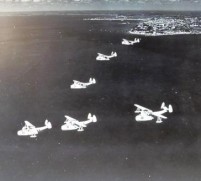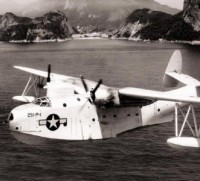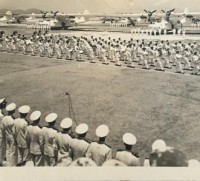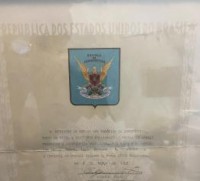U.S. NAVY VP SQUADRONS IN BRAZIL - THE TIMES OF RICHARD ARNOLD AT VP 94
5)PATROLS OFF BAHIA
Then we arrived in Bahia, the skipper of the squadron met us in a jeep and led us to a parking spot. This was a little unusual we thought. He told us there was a sub reported in the area and we would have to take off at midnight on a patrol. It was about dinner time so we had a few hours before takeoff. While we were still in the mess hall, the duty officer came in and said we would be ready- plane instead of going out. That meant unless somebody had a problem, we wouldn’t fly. So we were off the hook - we thought.
Not long after that while we were still relaxing, Frank Clark came in and said that Don Faulkner would appreciate it if I would go out with them. Jack told me Don had tried to turn in his wings that afternoon but the skipper wouldn’t let him. Jack said Don was having the same problem he had and Frank and I could take the plane away from him if necessaty and fly the patrol ourselves. I wasn’t crazy about the idea but agreed to do it. The flight itself was really routine but Don was in a state of panic the entire night time portion of it. He was in the left seat and I navigated the first portion of the flight. Those airplanes make strange noises and everytime something popped or cracked, he let out a panic stricken What was that? We sweated that out til dawn and the minute the sun came up, he relaxed and was fine.
We were out almost eleven hours using radar during the night and flying low during daylight hours trying to make visual contact. Our patrols were flown at 500 feet or cloud base, whichever is lower. As usual, we saw no subs but completed the patrol. So I had an experience with two plane commanders almost the same day having serious nerve problems. They both continued to fly, however, until the squadron was relieved. The submarine patrols were simple grid patterns flown by several airplanes covering adjacent sectors of ocean. They lasted usually ten to twelve hours and were usually boring as hell. We had a total of nine men in the crew, three pilots and six enlisted men. There were two 50 calibre machine guns in the blisters on each side of the fuselage, two 50s in the bow turret and one 30 calibre machine gun in a tunnel hatch. All the big guns were manned at all times during a patrol. We carried four 350 pound depth charges, two under each wing.
If we spotted a sub either on the surface or at periscope depth, we woulddive down and drop the bombs in a string from about fifty to seventy-five feet. The string of bombs was controlled by an intervalometer which spaced them about sixty feet apart. The idea was to straddle the sub with two on each side. They had pressure fuses and were set to explode at thirty feet. They would buckle the hull of the sub if they were close enough. We spent many hours practicing those low level attacks and drops just by seaman’s eye. That meant when it looked right, push the button. We had no bomb sight. Dick Rowland was one of our pilots who had sunk a sub. It also occurred before I joined the squadron but Dick and I were later sent to Rio together so I got to know him pretty well.
The sub he sunk had apparently broken open enough to allow many of the crew members to escape. The captain of the sub was one of them. Those who survived were captured by one of our Navy vessels in the area and taken to Recife to be interned. The U-boat skipper was an old hand and had been a U-boat skipper in WWI. He didn’t think anybody was good enough to sink his boat and asked to meet Dick. Dick flew to Recife and met with him. Dick got the DFC for the sinking.
Cont.



